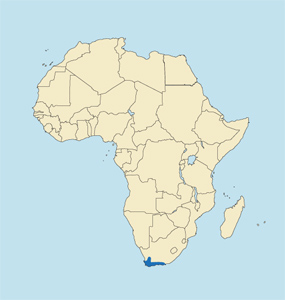 |
Raphicerus melanotis
Grysbok del Cabo (Sp), Kap-Greisbock (G), Grysbok, Raphicère du Cap (F), Grysbok (Af). The name grysbok, from the Dutch grys (gray) and bok (buck), was given it by early Dutch settlers in Cape Province in reference to its grizzled or gray appearance. Sometimes called grys steenbok.
DESCRIPTION Shoulder height 21-22 inches (54-56 cm). Weight about 22 pounds (10 kg).
The Cape grysbok is larger than a Sharpe grysbok and a little smaller than a steenbok. It is a small, rather stout antelope with its rump a little higher than its shoulders. The long, coarse coat is a deep reddish brown color speckled with numerous white hairs, giving it a grizzled appearance. The underparts are buff. Flanks, legs, neck and face are yellowish brown. The ears are large and pointed, grayish on the back and buffy white inside. There is a dark patch between the horns, and a light patch on the throat. The tail is very short. The Cape grysbok has very small false hoofs (differing from its close relatives, the Sharpe grysbok and steenbok, which have none). The horns (males only) are shorter than the ears, rising vertically from the head with a slight forward slant. Females are similar to males, but a little larger and without horns.
BEHAVIOR Lives alone, in pairs when breeding, or a female with her offspring. The young appear to be born during the summer.
Predominantly nocturnal, it is also active around sunrise and sunset, but lies up in thick cover during the day. Mainly a grazer, but does eat leaves and wild fruit. Can be a problem in vineyards by eating young shoots. Hearing is good, other senses not known. Moves about slowly with its head carried low. When faced with danger, it prefers to hide rather than trying to escape.
HABITAT Thick scrub bush, particularly on lower parts of hills.
DISTRIBUTION Western Cape and Eastern Cape provinces in South Africa.
REMARKS Because of its nocturnal nature the Cape grysbok is difficult to observe even where rather common.
TAXONOMIC NOTES No subspecies are recognized.
|





